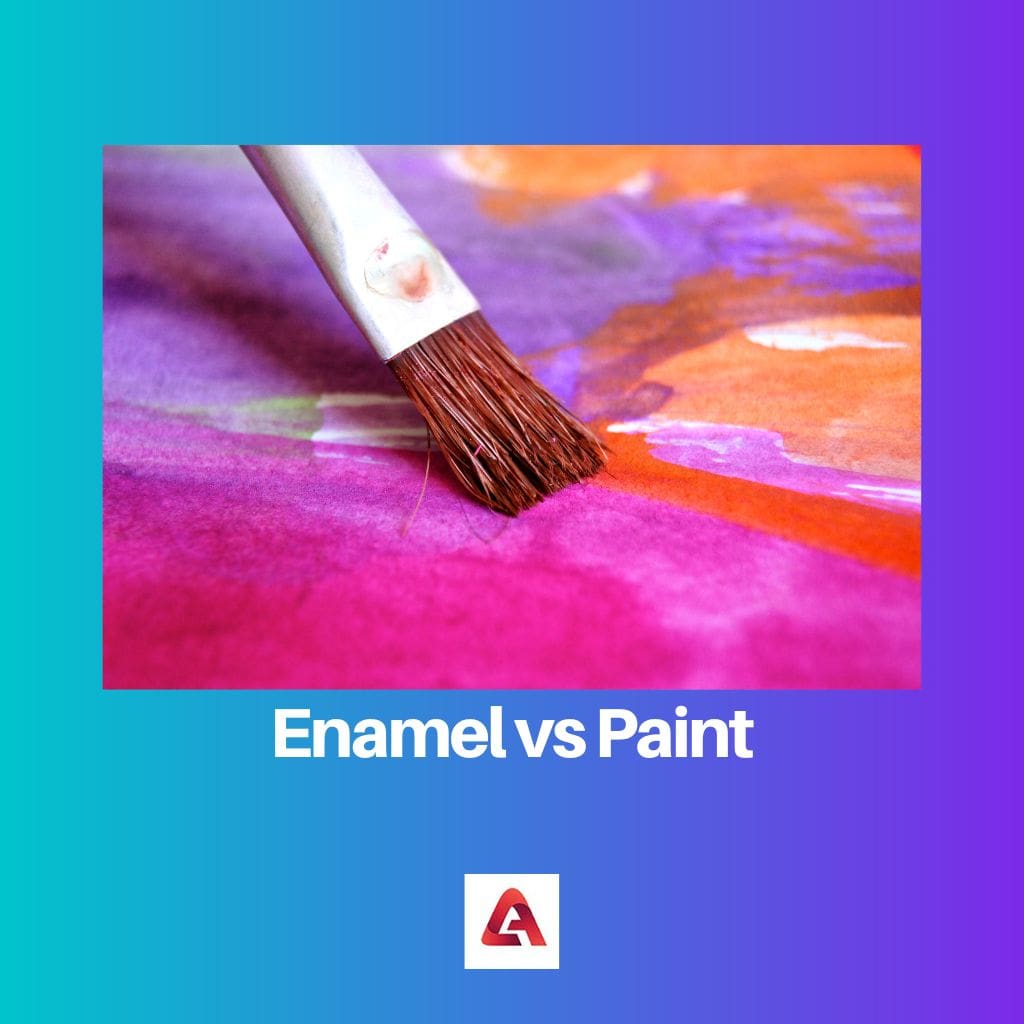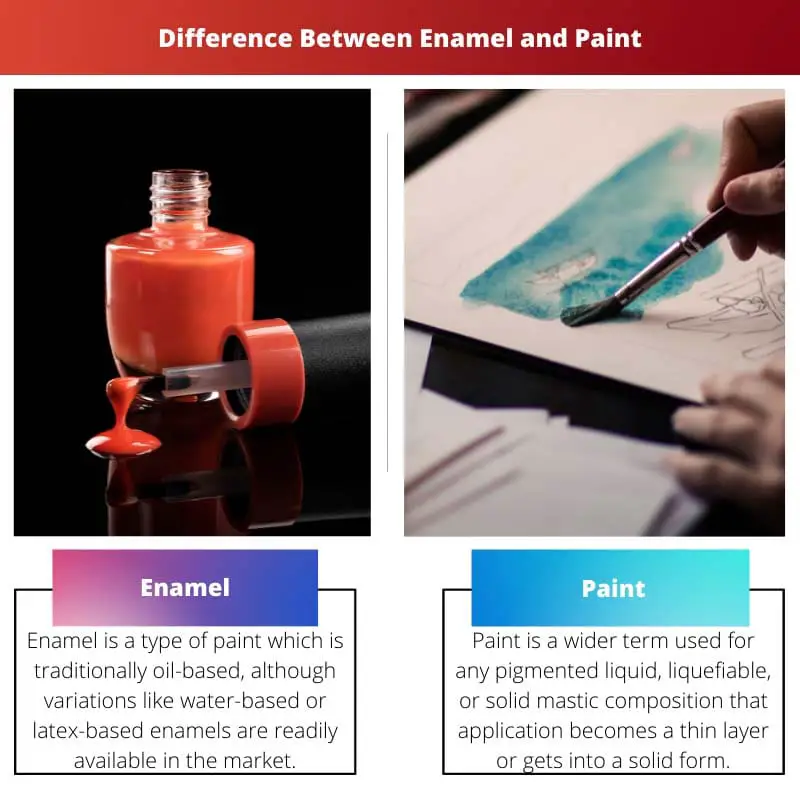Color adds grace and beauty to anything, from people’s faces to their houses, clothes, and accessories. Everything has an essence of color; few things are naturally painted like colors of natural things, for example, the green color of leaves, the red of apples, and so on.
Artificial colors can be added to things by painting with colors to make things look attractive. For example, walls are painted to attract people to enhance the beauty of a house, office, or any other place; cars or refrigerators, cell phones, bikes, etc., all are painted.
Every painting is not the same. Different types of paints are suitable for different materials wall paint can be used for painting cars or refrigerators because cars are metal surfaces, whereas walls are cemented.
Different brands manufacture different paints; for every type of material, manufacturers do improvisations in paints. Every type of paint has different tools and techniques as well.
Key Takeaways
- Enamel is a specific type of paint characterized by its hard, glossy finish, and durability, making it suitable for surfaces that require resistance to wear, such as metal, wood, or ceramics.
- Paint is a broader term encompassing a variety of liquid or mastic substances used to color, protect, or provide texture to surfaces, with various types (e.g., acrylic, latex, oil-based) suitable for different applications.
- The main difference between enamel and paint is that enamel is a specific type of paint with a hard, glossy finish. In contrast, paint is a more general term covering a wide range of substances with diverse properties and applications.
Enamel vs. Paint
Enamel is a type of paint used to protect or give a shiny look to wood and metals. This paint is suitable for objects that are exposed to weather changes. Enamel is washable and heat resistant. Paint is an umbrella term used for coating different surfaces to enhance and protect them.

Comparison Table
| Parameters of Comparison | Enamel | Paint |
|---|---|---|
| Definition | Type of paint | The wider term includes pigmented liquid of every type. |
| Types | Oil-based, water-based, latex-based | Cemented, aluminum, enamel, acrylic, etc. |
| Surface used on | Wood and metal | Walls, paper, wood, metal, plastic, rubber, etc |
| Washable | It is washable | Not every type of paint is washable |
| Texture | Glossy | Semi-glossy, glossy, eggshell finish, etc. |
What is Enamel?
Enamel is traditionally oil-based paint, although variations like water-based or latex-based enamels are readily available in the market. Enamel gets air-dried hard and used as protective as well.
Enamel is considered best for materials that are of regular use. Thus enamel helps protect the wear and tear products or the things that are subject to remaining outside the shelter and faces every type of climatic condition, such as cars. Thus, the enamel is considered best for furniture, vehicles, wood or metal.
Enamel also gives the objects a glossy shine, enhancing the beauty of things and giving a durable finish. They have heat-resistant properties, which make them perfect for kitchen appliances, such as refrigerators, microwaves, etc.; unlike acrylic paint, the enamel is washable. Thus, it is considered the best paint for regular washable things.
Enamel is ideal for tolerating harsh and moderate temperatures and is hot paint compared to others. It is related to at least 500 degrees Fahrenheit. And this property makes it of higher quality.
Enamel is used on a smooth surface, and not only enamel but every paint is also used on a smooth surface; thus, before using enamel, the surface is smoothened by sanding and applying primer in the case of wood. Metals are already smooth surfaces and, thus, do not need sanding.
The oil-based enamels are pretty dangerous to their fumes, and the solvents used to thin them can cause dizziness, headaches, or respiratory problems. But the, water-based enamels have less or no impact the oil-based enamels; they emit less dangerous fumes.

What is Paint?
Paint is a wider term for any pigmented liquid, liquefiable, or solid mastic composition that application becomes a thin layer or becomes solid. Paints add color and texture to the object to protect any surface.
Designing and manufacturing paints include four major components: pigment, binders, liquid, and additives. All of them are important to produce paint.
And their individual quality determines the quality of the final paint as a product. Binders help grip the pigment, and solvent turns the binder and liquid into thinner and fluid.
Paints are different, but these are the basic components of every type of paint. The quality of good paint is determined by a few factors applicable to all types of paints: paint should have good hiding power, it should be well resistant to the harsh atmosphere, fluidity and easy application, and of course, the cost of it.
Some of the properties of ideal paint, regardless of the type, are; corrosion-resistant, heat-resistant, water-resistant, chemical-resistant, opacity, tint strength, etc.. after manufacturing, these properties are checked properly before the retail sale. Several types of paints are available in the market by different brands like oil paint, enamel paint, emulsion paint, aluminum paint, bituminous paint, cement paint, acrylic paint, velvet paint, synthetic rubber paint, anti-corrosive paint, etc.
Paints are also distinguished based on their uses, for example, external and interior or internal use. For external use usually, enamel paint is preferred, and for interiors, a wide range is available, like satin finish paints, eggshell finish paints, semi-gloss paints, etc.

Main Differences Between Enamel and Paint
- Enamel is a type of paint, whereas paint includes a wide range of paints.
- Enamels are used for wood and metal surfaces; on the contrary, paint can be used on any material.
- Enamel has three types; oil-based, water-based, or latex-based, whereas paints are of several types like cement, acrylic, bituminous, aluminum, etc.
- Enamel provides a glossy finish; conversely, not every paint provides a glossy finish compared to enamel.
- Enamel is washable, but every paint is not washable.

- https://www.sciencedirect.com/science/article/pii/S0043164807005704
- https://www.sciencedirect.com/science/article/pii/S0013935109001315

The detailed analysis of enamel and paint is an insightful piece, offering valuable information and a clear distinction between the two. The comparison table plays a crucial role in summarizing the key characteristics of enamel and paint, enabling readers to discern their unique features effectively. Overall, an enlightening and comprehensive read.
The article provides a comprehensive analysis of enamel and paint, elucidating the distinct properties and applications of each. The detailed explanation about enamel’s application on materials exposed to weather conditions and its glossy features offers valuable insights to the readers. The comparison table effectively summarizes the characteristics of enamel and paint, aiding in clarity and understanding.
I appreciate the comprehensive overview of enamel and paint, which underscores the differences between the two and their diverse applications. The comparison table is particularly helpful in highlighting the unique attributes of enamel and paint, enabling readers to discern their properties effectively.
The article delivers a comprehensive comparison of enamel and paint, providing valuable insights into their distinct characteristics and applications. Praises to the detailed discussion on enamel’s heat-resistant features and glossy finish. The comparison table effectively summarizes the properties of enamel and paint, contributing to a clear and comprehensive understanding.
The detailed comparison of enamel and paint is excellently presented, providing a comprehensive understanding of their unique features and uses. The discussion on enamel’s heat-resistant properties and its suitability for weather-exposed objects is particularly intriguing and informative.
The article’s comparison of enamel and paint is highly informative and engaging, capturing the distinct applications and properties of each. The detailed analysis of enamel’s heat-resistant features and glossy finish enhances the reader’s understanding of the topic, offering valuable insights.
The article provides an extensive and insightful comparison of enamel and paint, clarifying their different uses and application. I appreciate the detailed explanation on how enamel is best suited for items that are exposed to weather and regular use, whereas paint is a broader term and depends on several factors such as the type of surface and application. The comparison table is very informative and helpful for distinguishing the characteristics of enamel and various types of paint materials.
The article is an excellent resource for anyone seeking to understand the differences between enamel and paint. The information is clearly presented and contributes to the knowledge of the reader.
I agree, the detailed description of enamel and its uses, combined with the comparison with paint, provides a comprehensive understanding of the topic. The information on the components of paint and the quality factors are particularly enlightening.
The article offers a comprehensive examination of enamel and paint, providing valuable insights into their distinct characteristics and utilities. The detailed analysis of enamel’s application on objects exposed to varying climatic conditions and its glossy finish enriches the reader’s understanding of the topic. The comparison table effectively summarises the properties of enamel and paint, enabling readers to discern their differences clearly.
I found the comparison between enamel and paint to be exceptionally informative and detailed. The article effectively delineates the distinct properties of enamel and paint, enhancing the reader’s knowledge and understanding of the topic. The in-depth discussion about enamel’s suitability for weather-exposed items is particularly enlightening.
I concur, the article presents a detailed comparison of enamel and paint, showcasing their unique uses and attributes. The discussion about enamel’s heat-resistant properties and its glossy finish contributes to a comprehensive understanding of the topic and offers valuable insights.
The article provides an in-depth comparison of enamel and paint, offering comprehensive insights into their unique properties and applications. The detailed discussion on enamel’s glossy finish and heat-resistant properties enriches the reader’s understanding of the topic. The inclusion of the comparison table is particularly helpful in summarizing the key differences between enamel and various forms of paint, contributing to a clear understanding.
I concur, the article offers an extensive and informative comparison of enamel and paint, providing valuable insights into their distinct properties and uses. The detailed analysis of enamel’s heat-resistant features and glossy finish enhances the reader’s understanding, contributing to a clear and comprehensive overview of the topic.
The article delivers an in-depth comparison of enamel and paint, emphasizing their unique features and applications. The detailed description of enamel’s heat-resistant properties and durability makes it an interesting read. The discussion on the surface types suitable for enamel and various forms of paint is very insightful.
I agree, the article effectively captures the distinctive characteristics of enamel and paint, providing valuable insights into their uses and applications. The detailed description of enamel’s gloss and heat-resistant properties is particularly intriguing and enriches the understanding of the topic.
The comparison between enamel and paint is well-presented and informative. The article effectively delineates the characteristics of enamel and paint, providing readers with a thorough understanding of each. The discussion on enamel’s application for items exposed to weather conditions offers valuable insights.
The article delivers a thorough comparison of enamel and paint, providing an illuminating discussion on their respective properties and applications. The emphasis on enamel’s use for materials exposed to weather changes and its glossy characteristics enriches the reader’s knowledge and understanding. The detailed comparison table effectively highlights the key differences between enamel and various types of paint.
I agree, the comprehensive analysis of enamel and paint offers valuable insights into their distinct properties and applications. The article’s emphasis on enamel’s durability and gloss, along with the comparison table, enables readers to effectively discern the unique attributes of enamel and paint.
The article’s detailed comparison of enamel and paint is highly informative and engaging. The discussion on enamel’s application for weather-exposed materials and its glossy properties is particularly intriguing and illuminating.
The article provides an insightful analysis of enamel and paint, elucidating their unique properties and applications. The detailed discussion on enamel’s heat-resistant features and glossy finish offers valuable insights to the readers, enhancing their understanding of the topic. The comparison table effectively summarizes the characteristics of enamel and paint, contributing to clarity and comprehension.
I found the detailed comparison between enamel and paint to be highly enlightening and informative. The article effectively captures the distinct characteristics of each, offering readers valuable insights into their properties and applications. The inclusion of the comparison table is particularly helpful in highlighting the unique attributes of enamel and paint.
The article’s comprehensive comparison of enamel and paint provides valuable insights into their distinct features and uses. The detailed analysis of enamel’s glossy finish and heat-resistant properties enhances the reader’s understanding of the topic. The comparison table effectively summarizes the key differences between enamel and various forms of paint, contributing to a clear understanding.
The article introduces a well-explained comparison between enamel and paint, offering valuable insights into their properties and use. The discussion about the different types of paint suitable for diverse applications adds depth to the understanding of the topic. The description of enamel’s glossy finish, durability, and applications on various surfaces is particularly intriguing.
I found the comparison between enamel and paint to be highly informative and engaging. The detailed discussion on enamel’s glossy finish and suitability for specific materials enriches the reader’s knowledge of the topic.
The article’s explanation of enamel’s properties and applications is indeed fascinating. The inclusion of the comparison table contributes to the clear understanding of enamel and paint characteristics.